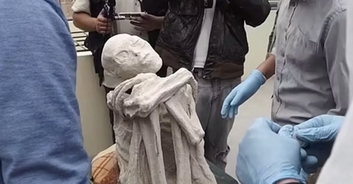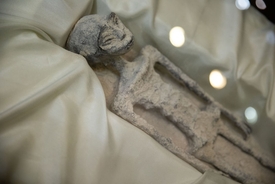For more than 80 years, the disappearance of Amelia Earhart has remained a mystery to the world. The pioneering aviator was the first woman to ever fly solo across the Atlantic ocean - a feat for which she attained worldwide fame. However, during a 1937 flight over the Pacific, she and her co-pilot went missing, and neither their bodies nor the plane were ever recovered. Or so we thought.
For years, it was believed that she had perhaps survived a crash-landing, and was living on a deserted island somewhere. However, those theories were soon scuppered when, in 1940, a search party found some bones on the Japanese island of Nikumaroro. Almost immediately, though, they were written off as the remains of a man, and so they couldn't possibly have been those of the female pilot.
But now the bones have been re-examined - and they're very likely to be Earhart's.
Richard Jantz, a professor of anthropology at the University of Tennessee, took a second look at seven of the bones that were originally analyzed 78 years ago in order to see whether the original conclusions still held up once more modern techniques were applied.
"Forensic anthropology was not well developed in the early 20th century," Jantz explained. "There are many examples of erroneous assessments by anthropologists of the period. We can agree that Hoodless [the physician who examined the bones before] may have done as well as most analysts of the time could have done, but this does not mean his analysis was correct."
Using a specially-designed computer program which is utilized by forensic anthropologists around the world, Jantz was able to determine that the bones did come from a woman. What's more, using known information about Earhart's height, age, and build, Jantz was able to say that the bones had more similarity to the pilot than 99 per cent of other individuals compared as part of a large reference sample.
Based on this information, Jantz has concluded that "until definitive evidence is presented that the remains are not those of Amelia Earhart, the most convincing argument is that they are hers."
As well as the bones, other evidence found at the original scene suggested that the remains belonged to Earhart. A woman's shoe was discovered close to the body, as was a box that originally contained a sextant similar to the one her co-pilot used, and a bottle of herbal liqueur, which she herself was known to drink.
Jantz also decided to further rule out any other possible owners of the bones by investigating other disappearances that happened in the same area. What he found was that it was unlikely for the remains to have ended up in that specific area from other boat wrecks that had happened nearby, and that the items found near the body were unlikely to have belonged to a male crew that went missing in 1929.
So, given that Earhart "was known to have been in the area of Nikumaroro Island [when] she went missing, and human remains were discovered which are entirely consistent with her and inconsistent with most other people," the argument seems pretty solid.
Unfortunately, because the original analyst threw away the bones, all further tests have been conducted using photographs and high-accuracy estimates - so there is obviously still a margin for error in this finding. However, given the 99 per cent chance that it is Earhart, along with the circumstantial evidence discovered at the original scene, it does seem extremely likely that the mystery has finally been solved.





